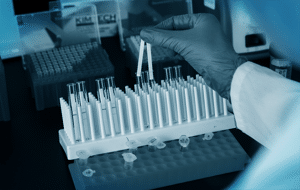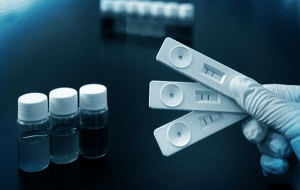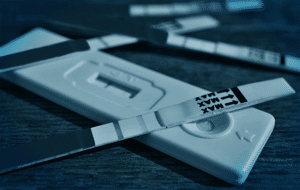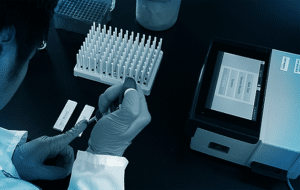>
>
>
Antibody Labeling and Analyte Detection for Lateral Flow Assays
Antibody Labeling and Analyte Detection for Lateral Flow Assays
- By George Parsons, Ph.D.
- August 17, 2018

If the period at the end of this sentence were printed on paper, it would probably contain less than 1019 molecules or atoms of ink[1]. By contrast, a lateral flow pregnancy test that shows a positive is detecting about 1010 molecules of human chorionic gonadotropin (hCG)[2], assuming a cutoff of about 6 mIU/mL and a sample size of roughly 50 uL. In a lateral flow assay (LFA) it is typically not the analyte such as hCG that is detected but an antibody labeling the analyte. hCG has a molecular weight of about 38 kD and mouse IgG antibodies have a molecular weight of about 150 kD, so even if several antibodies are bound to each analyte molecule, it is going to be difficult to detect such a small amount of material.
The task is made even more difficult by the fact that proteins such as hCG and antibodies do not absorb visible light. Uncooked egg whites offer proof of this statement. Even though egg whites contain about 85% protein, they are translucent. Only when egg white proteins are denatured by cooking or beaten with air to make a meringue do they scatter ambient light and appear to be white.
Fortunately, innovative chemistry has developed several antibody labeling materials that can be used to modify antibodies to enhance their detectability[3]. These antibody labeling materials include gold nanoparticles, colored cellulose particles, colored latex particles, magnetic particles, carbon nanoparticles, quantum dots, fluorophores and various enzymes. All of these antibody labeling materials can be used to modify detector antibodies without adversely affecting their ability to bind to the relevant target analyte. Antibodies are incredibly durable reagents and can be modified with as many as 40 added label molecules without affecting their affinity or specificity. Antibody labeling with as many as 60 labels is chemically feasible but then reagent stability and shelf life may be compromised. Antibody labeling materials also can be optimized to minimize non-specific binding to other components of the LFA which could adversely affect sensitivity.
Gold nanoparticles are the most commonly used label for LFA. While the exact color depends on the size of the nanoparticle, particles that appear red are most commonly used in LFAs. Colored latex beads offer a wide range of colors that can be used to implement multiplexing of LFA where more than one analyte at a time can be detected. Cellulose nanobeads offer many of the same advantages as latex beads but according to the manufacturer offer 8-10 times greater sensitivity than conventional gold nanoparticles[4]. All of these labels rely on detecting the color of the label on the surface of the LFA. What that really means is that some of the ambient light is being absorbed by the label and converted into invisible heat. What is detected is the light that is not absorbed by the label but reflected back.
More sensitivity can be gained by using labels that are fluorescent. In fluorescence, a certain color or wavelength of light is absorbed by the label and after a very short time, a slightly different color of light is emitted. Filters can be used to stop the original light from being detected, and only the emitted light is thus seen against a diminished background. Direct labels such as fluorescein isothiocyanate or fluorescently labeled latex particles have been used.
Magnetic particles can be used as visible labels in LFAs, but the technologies used in reading magnetic audio tapes and computer disks can also be employed to achieve even better sensitivities[5]
Carbon nanoparticles derived from soot obtained by burning various materials including toluene have been used as labels in LFAs[6]. One strategy employed by a company named Vivacta was to use the thermal properties of carbon nanoparticles when irradiated by infra-red light to change the signal detected on a piezoelectric film.
Enzymes such as horseradish peroxidase and alkaline phosphatase have long been used in other immunoassay formats such as microtiter plate ELISA. They have been adapted for use in LFAs as well[7], and they provide impressive sensitivity down to 0.8 ng/mL of progesterone. In contrast to the enzyme substrates used in microtiter plate ELISAs, the substrate used in the reference cited in this reference produces an insoluble product that precipitates on the device. However, this increase in sensitivity comes at the cost of another reagent (the substrate) and another step in the assay process. Unbound enzyme in the labeled reagent must be washed away either with continued sample flow or an additional wash step before the substrate can be added. This added complexity is a disadvantage in a resource limited setting and adds operator training and compliance requirements.
Added complexity is the cost of all of the labels cited above that increase sensitivity over that achieved with gold nanoparticles or other labels that can be read by the naked human eye. Fluorescence reading requires instrumentation that can generate high intensity light of a certain wavelength or color, filters that can block stray light from that light source, and a light detection device to capture the emitted light. Magnetic particles need instrumentation to detect their tiny magnetic fields. Carbon nanoparticles are not as visually detectable as gold nanoparticles, dyed latex particles or cellulose nanobeads and only outperform when used with high intensity infrared light sources and specialized detection systems.
The unaided human eye is a remarkably efficient device for detecting light including reflected light from LFAs. It is sensitive to light from 380 nm (violet) to 800 nm (red)[8] but is most sensitive to green light at a wavelength of 555 nm. The human eye cannot see light outside of these ranges. Men and women also differ in their ability to see colors. Woman have been found on average to have better sensitivity to color and to better differentiate between colors than men[9].
Quantitation using unaided LFAs means that the user has to be able to differentiate between different intensities of color. In a sandwich assay such as one for hCG, a darker color band means that more analyte has been detected. However, quantitation is not needed for pregnancy tests. There is no such thing as being a little pregnant. The test and the condition for which it is testing is binary. Either the test is positive or it is negative. However, other tests can benefit from quantitation as more than one condition can exist. Thyroid stimulating hormone (TSH) is one such test. Someone who has normal thyroid function will have a TSH blood level between 0.1 and 4 uIU/mL in their blood. Levels above the high cutoff are at higher risk of being hypothyroid. Levels below the low cutoff indicate a higher risk of being hyperthyroid. Printed color charts can be helpful in estimating levels, but reliable quantitation requires instrumentation, which will be the subject of a future blog.
Our team of engineers and scientists can help you determine the specification for antibody labeling for your test. Feel free contact us with any questions.
[1] https://what-if.xkcd.com/106/
[2] Cole LA, Sutton-Riley JM, Khanlian SA, Bokovskaya M. Rayburn BB and Rayburn WF, Sensitivity of Over-the-Counter Pregnancy Tests: Comparison of Utility and Marketing Messages, J Am Pharm Assoc 45, 608-615 (2005)
[3] Sajid M, Kawde A and Daud M, Design, Formats and Applications of Lateral Flow Assays, J Saudi Chem Soc., 19, 689-705 (2015)
[4] https://www.asahi-kasei.co.jp/asahi/en/news/2014/e141216.html
[5] Barnet JM, Wraith P, Kiely J, Persad R, Hurley K, Hawkins P and Luxton R, An Inexpensive, Fast and Sensitive Quantitative Magneto-Immunoassay for Total Prostate Specific Antigen, Biosensors(Basel) 4(3), 204-220, (2014)
[6] Posthuma-Trumpie G, Wichers JA, Koets M, Berendsen LBJM and van Amerogen A, Amorphous carbon nanoparticles: a versatile label for rapid diagnostic (immune) assays, Anal Bioanal Chem 402(2) 593-600 (2012)
[7] Samsonova JV, Safronova VA and Osipov AB, Pretreatment-Free Lateral Flow Immunoassay for Progesterone determination in whole cow’s milk, Tantala 132, 685-689 (2015)
[8] https://light-measurement.com/spectral-sensitivity-of-eye/
[9] https://www.livescience.com/22894-men-and-women-see-things-differently.html
Latest News
March 18, 2024







